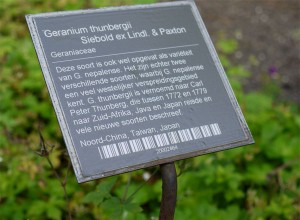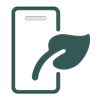Introduction
Plant labelling is a topic we frequently discuss with our clients. Opinions differ and there are a number of options available. All the alternatives available have different advantages and disadvantages and deciding on a particular labelling solution often comes down to personal preferences. When working as a curator at Hortus Botanicus Amsterdam, Kevin Frediani looked into this challenge in some detail, coming up with a creative approach, inspired by a technology used for shipping containers.
Kevin, now curator at Paignton Zoo Environmental Park, has kindly given us permission to republish his article, originally printed in the PlantNetwork newsletter 38, July 2009.
The photos in the article were taken when I visited the curator at Hortus Botanicus Amsterdam, Reinout Havinga in August.
I hope you will find the article useful and would like to thank Kevin, Reinout and Laura Davies for sharing it with the rest of the community.
Affordable and flexible plant labels
By Kevin Frediani, first published in the PlantNetwork newsletter no.38, July 2009.
At the heart of all botanic gardens is the accurate documentation about the many plants grown in the garden; it is essential for efficient management of the living collections and for the success of research and conservation programmes (RBGE, 2009). How to label efficiently and effectively both for the institutions own use and for the benefit of the visitor has always been a bit of a compromise with regards to the state of the garden finances, the ‘traditional’ house style, label durability and the degree of flexibility they afford.
Recently Paignton Zoo Environmental Park have invested in a new system that addresses their labeling requirements through adopting technology utilized for producing shipping container labels. The system was one that had previously been used for a number of years in Amsterdam at De Hortus Botanicus by the scientific officer and was introduced to one of the authors (Kevin), when he worked there in 2006-2008. The Paignton systems uses a heat transfer label produced on a Brady ‘minimark’ industrial label printer. The system uses 5 and 7 year external grade vinyl that offers an affordable sign and label making solution that is compact, fast, and incredibly versatile when used with plant labels made of powder coated or stainless steel.
Here a piece about Wales too…
A thermal transfer printer is a specialized printer for printing directly on rolls of plastic labels for use in nursery pots and/or rolls of adhesive permanent polyester outdoor labels which are printed and then stuck onto either powder coated steel, stainless steel or aluminium labels. Earlier such systems have been successfully used in tropical environments previously (Chapin & Smith, 1998). It comes with its own software which can be fully integrated into a desktop or laptop PC where it has proved useful for high volume in-house label printing needs and can also print bar codes. At an entry level scale the Brady minimark printer at Paignton cost about £750 and offers exceptional print quality at an economical price.
Here the cost and details of the other system…
Benefits if this system include:
- Flexibility to create your own messages, symbols, pictograms, barcodes, mailing labels, pipe markers and signs from your own PC using the supplied software
- Can choose from a wide range of tape colours, lengths, widths to suit multiple applications including production of your own heath and safety signs via the different colour vinyl’s available
- Prints 203 DPI print resolution on a variety of materials – Vinyl, Polyester, Paper, Direct Thermal Paper and Die Cut Labels
- Max. print width 104mm. Print length 25mm-1m with its own cutter function

The high grade resin wax ribbon is critical to the success of outdoor labels this coasts £69 for a 90 meter roll which will serve up to 4 label rolls. The labels are a specialized material that is resistant to UV, water, and other outdoor impacts in width of up to 100mm in 20 meter lengths coasting £128 each. They are adhesive backed so they just peel off and can be stuck onto the metal labels. We chose a high quality label to withstand the impact of most environmental conditions and brown because we wanted the labels to blend in with the black powder coated labels. The Paignton Zoo Environmental Park use white labels on a brown background and print separate bar codes for the rear of the label so you see the plants and not a grave yard of labels.
The steel labels have been produced though an external fabrication welder at a cost of £150 per 100 (cut, welded, sanded, shot blast and powder coated). These labels should last for years and have the benefit of being fully reusable as they can accept new vinyl and the old can be pealed off once soaked for a while in degreasing solution. The cost of each label including printing is less than £1 at time – providing a label that is £2.50 and can be updated for £1 at any time in the future!
References:
- Royal Botanic Garden Edinburgh,
Plant labels - Chapin, M.H. and Smith, S. (1998) Tagging Along in Tropical Botanic Gardens – The Experience of the National Tropical Botanical Garden, Hawai’i. BGCI News Volume 3 Number 1 – December 1998
